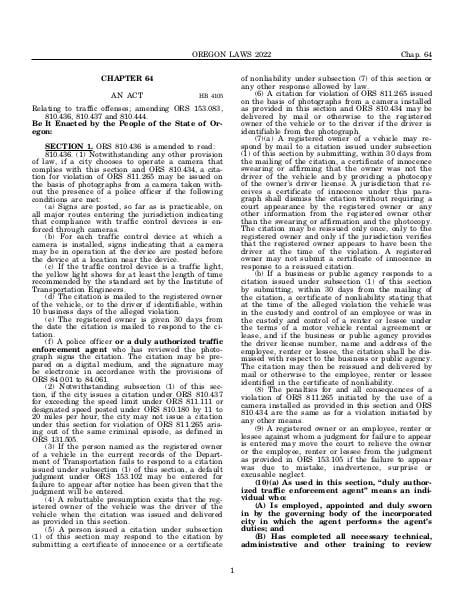ORS 810.444
Citations based on photo radar in urban high crash corridors
- response to citation

Amended by HB 4105
Effective since January 1, 2023
Relating to traffic offenses; amending ORS 153.083, 810.436, 810.437 and 810.444.
(1)
Notwithstanding any other provision of law, in the jurisdiction operating a fixed photo radar system under ORS 810.443 (Photo radar):(a)
A citation for speeding may be issued on the basis of fixed photo radar if:(A)
A sign that provides drivers with information about the driver’s current rate of speed is posted between 100 and 400 yards before the location of each fixed photo radar unit; and(B)
A police officer who has reviewed the photographic evidence of the conduct signs the citation.(b)
A rebuttable presumption exists that the registered owner of the vehicle was the driver of the vehicle when the citation is issued and delivered as provided in subsection (2) of this section.(c)
An individual issued a citation under this subsection may respond to the citation by submitting a certificate of innocence under subsection (3)(a) of this section or may make any other response allowed by law.(d)
A business or public agency issued a citation under this subsection may respond to the citation by submitting an affidavit of nonliability under subsection (3)(b) of this section or may make any other response allowed by law.(2)
A citation issued on the basis of fixed photo radar may be delivered by mail or otherwise to the registered owner of the vehicle or to the driver. The citation may be prepared on a digital medium, and the signature may be electronic in accordance with the provisions of ORS 84.001 (Short title) to 84.061 (Federal electronic signatures law partially superseded).(3)
Intentionally left blank —Ed.(a)
An individual named as the registered owner of a vehicle in current records of the Department of Transportation may respond by mail to a citation issued under subsection (1) of this section by submitting a certificate of innocence within 30 days from the mailing of the citation swearing or affirming that the registered owner was not the driver of the vehicle and by providing a photocopy of the registered owner’s driver license. A jurisdiction that receives a certificate of innocence under this paragraph shall dismiss the citation without requiring a court appearance by the registered owner or any other information from the registered owner other than the swearing or affirmation and the photocopy. The citation may be reissued only once, only to the registered owner and only if the jurisdiction verifies that the registered owner appears to have been the driver at the time of the violation. A registered owner may not submit a certificate of innocence in response to a reissued citation.(b)
If a business or public agency named as the registered owner of a vehicle in current records of the Department of Transportation responds to a citation issued under subsection (1) of this section by submitting an affidavit of nonliability within 30 days from the mailing of the citation stating that at the time of the alleged speeding violation the vehicle was in the custody and control of an employee, or was in the custody and control of a renter or lessee under the terms of a rental agreement or lease, and if the business or public agency provides the driver license number, name and address of the employee, renter or lessee, the citation shall be dismissed with respect to the business or public agency. The citation may then be issued and delivered by mail or otherwise to the employee, renter or lessee identified in the affidavit of nonliability.(4)
If the registered owner, employee, renter or lessee fails to respond to a citation issued under this section, a default judgment under ORS 153.102 (Entry) may be entered for failure to appear after notice has been given that the judgment will be entered.(5)
The penalties for and all consequences of a speeding violation initiated by the use of fixed photo radar are the same as for a speeding violation initiated by any other means.(6)
A registered owner, employee, renter or lessee against whom a judgment for failure to appear is entered may move the court to relieve the registered owner, employee, renter or lessee from the judgment as provided in ORS 153.105 (Relief from default judgment) if the failure to appear was due to mistake, inadvertence, surprise or excusable neglect. [2015 c.721 §2]
Source:
Section 810.444 — Citations based on photo radar in urban high crash corridors; response to citation, https://www.oregonlegislature.gov/bills_laws/ors/ors810.html.